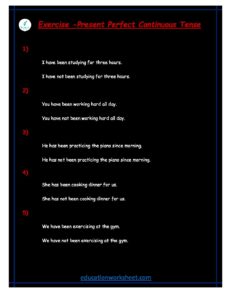changing Past Perfect Continuous Tense to negative and positive worksheets
changing Past Perfect Continuous Tense to negative and positive
Introduction
Understanding the intricacies of English grammar is a fundamental aspect of effective communication. Among the various tenses in English, the Past Perfect Continuous tense plays a crucial role in describing actions or events that occurred over a period of time in the past. In this comprehensive guide, we will explore how to change sentences in the Past Perfect Continuous tense into both negative and positive forms. By delving into this subject, you will gain a deeper understanding of the tense and improve your overall proficiency in English grammar.
Part I: Past Perfect Continuous Tense – An Overview

Before we delve into the conversion of Past Perfect Continuous tense sentences into positive and negative forms, let’s establish a clear understanding of the tense itself.
- Definition and Structure
The Past Perfect Continuous tense is used to describe actions that started in the past and continued for some time before another event occurred in the past. It is formed by using “had been” followed by the base form of the verb with an -ing ending. The basic structure is as follows:
Positive: Subject + had been + verb-ing
Negative: Subject + had not (hadn’t) been + verb-ing
- Use of Past Perfect Continuous Tense
The Past Perfect Continuous tense is employed in various situations, such as:
a. To express actions that started in the past and continued up to a certain point in the past.
b. To describe the duration of an action or event in the past.
c. To emphasize the connection between two events in the past, with one action occurring over a period before the other.
Part II: Changing to Negative Form
Now, let’s focus on how to change sentences in the Past Perfect Continuous tense into the negative form. This involves adding “not” after “had” to create the contraction “hadn’t.”
- Step-by-Step Process for Changing to Negative Form
Step 1: Identify the Past Perfect Continuous sentence. Example: “She had been working on the project for three hours.”
Step 2: Add “not” after “had” to form the contraction “hadn’t.” Negative Form: “She hadn’t been working on the project for three hours.”

Here are some common examples of converting positive Past Perfect Continuous sentences into negative ones:
a. Positive: “I had been studying all night.” Negative: “I hadn’t been studying all night.”
b. Positive: “They had been waiting for the bus since morning.” Negative: “They hadn’t been waiting for the bus since morning.”
c. Positive: “He had been playing the piano for two hours.” Negative: “He hadn’t been playing the piano for two hours.”
Part III: Changing to Positive Form
Converting Past Perfect Continuous sentences into positive form is a relatively straightforward process. Here, we will explore how to make this transformation effectively.
- Step-by-Step Process for Changing to Positive Form
Step 1: Identify the Past Perfect Continuous sentence in the negative form. Example: “She hadn’t been working on the project for three hours.”
Step 2: Remove “not” from the contraction “hadn’t” to revert to “had.” Positive Form: “She had been working on the project for three hours.”
- Common Positive Past Perfect Continuous Examples
Let’s examine some examples of converting negative Past Perfect Continuous sentences into positive ones:
a. Negative: “I hadn’t been studying all night.” Positive: “I had been studying all night.”
b. Negative: “They hadn’t been waiting for the bus since morning.” Positive: “They had been waiting for the bus since morning.”
c. Negative: “He hadn’t been playing the piano for two hours.” Positive: “He had been playing the piano for two hours.”
Part IV: Advanced Usage and Tips
To master the transformation of Past Perfect Continuous tense sentences into negative and positive forms, consider the following advanced usage and tips:
- Emphasizing Specific Events
In the Past Perfect Continuous tense, you can emphasize a specific event that interrupted the ongoing action by using “when” or “before.” For example:
Positive: “She had been studying when the phone rang.”
Negative: “She hadn’t been studying when the phone rang.”
- Maintaining Consistency
When converting sentences from positive to negative or vice versa, it’s crucial to maintain consistency in tense and subject-verb agreement. Ensure that the tense of the auxiliary verb “had” matches in both the positive and negative forms.
- Interrogative Form
To transform Past Perfect Continuous sentences into questions, you can simply switch the order of the subject and “had,” and use a question mark at the end. For example:
Positive: “Had she been working on the project for three hours?” Negative: “Hadn’t she been working on the project for three hours?”
Part V: Practical Examples and Exercises
changing Past Perfect Continuous Tense to negative and positive worksheets

To reinforce your understanding of converting Past Perfect Continuous tense sentences into negative and positive forms, let’s practice with some practical examples and exercises.
Exercise 1: Convert the following sentences from positive to negative form.
- “We had been preparing for the exam for weeks.” Negative: __________________________________________
- “He had been jogging in the park every morning.” Negative: __________________________________________
- “She had been cooking dinner when the power went out.” Negative: __________________________________________
Exercise 2: Convert the following sentences from negative to positive form.
- “I hadn’t been reading that book for long when I fell asleep.” Positive: __________________________________________
- “They hadn’t been rehearsing for the play for very long.” Positive: __________________________________________
- “He hadn’t been working on the car when it suddenly broke down.” Positive: __________________________________________

